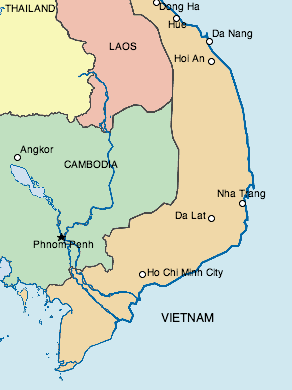Facing Cambodia’s Past at Tuol Sleng Genocide Museum
Thursday, October 24th, 2002
We got our second wind and almost reluctantly mounted a motorcycle taxi to do what we (or at least I) came here to do and that is to see, after more than 30 years of war and terror, what has finally happened to this country that has survived carpet bombing under Nixon’s secret orders to go after Viet Cong in the 70’s.
Remember Nixon told us we were not bombing Cambodia. We weren’t-officially-our pilots and “advisors” dressed in T shirts and shorts, along with Cambodian pilots, were. Cambodia has somehow survived four years of Pol Pot’s murderous regime and his attempt to completely erase Cambodia’s past by outlawing money and dismantling the entire education system and then another 20 years of political instability and armed insurgencies and coups by various political aspirants, including former president Sihanouk and his own son.
Tuol Sleng Genocide Museum, opened in 1980, is a former high school that became the Khmer Rouge’s S-21 secret prison. After the Khmer Rouge revolutionaries under Pol Pot and inspired by Chairman Mao took over the city in April 1975, they immediately forced the entire population into the countryside as part of its radical social program to turn the country into an agrarian society.
Young children were trained as guards that became exceptionally cruel to the engineers, technicians, intellectuals, professors, teachers, students and ministers and diplomats that ended up in mass graves in the extermination camps of Choeng Ek. As the revolution reached greater heights of insanity the torturers and executioners who worked here killed their predecessors and were in turned killed by those who replaced them. When asked if the guards knew they would end up being killed the tour guide said they probably did not owing to the paranoia and secrecy of the regime. S-21 and all its many branches was headed by a former mathematics teacher by the name of Kang Kek Ieu or Comrade Duk.
When asked, our guide said that the movie “The Killing Fields” was only about 40% true…suggesting that the horror was about 60% greater than the film allowed. The Khmer Rouge, like the Nazis, were meticulous in keeping records and the walls of the school-turned-prison and now museum is covered with the photographs of the men, women and children who were later killed or sent to the countryside to work in the rice fields. Incidentally, several foreigners from Australia, France and the US were also held here and tortured before being murdered.
The situation was made especially complex by the fact that China supported not only Pol Pot but also Sihanouk who is still living in Beijing after all these years. Thailand supported the Khmer Rouge and harbored Pol Pot in a fenced compound throughout the 80’s, the Soviet Union supported Vietnam-a historical enemy of Cambodia’s-and the US and the UN supported anyone that was anti-Vietnamese, including the Khmer Rouge, because after all the Vietnamese were communist. Never mind that the Khmer Rouge was communist too…so the Western world stood by silently while Vietnam intervened in 1979 to help insurgency groups try to kick out the Khmer Rouge.
But the Vietnamese stayed. Finally in 1989, when, suffering with it’s own disastrous economic experiment, it withdrew it’s troops. However, with most of the Vietnamese gone, the opposition coalition, still dominated by the Khmer Rouge, launched a series of offensives against the government forces and in the first 8 months of 1990 another 2000 Cambodians lost their lives. Well, it’s all as clear as mud to me too but you get the idea. (The expansion of the Vietnam War into Cambodia and events through the mid 70’s are documented by William Shawcross in “Sideshow: Kissinger, Nixon & the Destruction of Cambodia.”)
The UN
Then a plan was devised whereby the UN was to supervise the administration of the country and ensure fair elections in 1993, which it did, before it packed up and went home leaving behind a mess because so many of the powers involved in brokering the deal had their own agendas. It was a travesty that the Khmer Rouge was allowed to play a part in the process and must have seemed like a cruel joke to the Cambodians who had lost family members under its rule. To make it worse, when the UN left it took weapons away from rural militias who provided the backbone of the government defence force against the Khmer Rouge.
According to analysts, by 1994, when it was finally outlawed by the government, the Khmer Rouge was probably a greater threat to the stability of Cambodia than at any time since 1979. But in 1994 the Khmer Rouge resorted to a new tactic of targeting tourists; three people were taken from a taxi on the road to Sihanoukvile and shot and a few months later another three foreign backpackers were taken from a train bound for Sihanoukville and executed. This is the road that Bob is going to take back across the Thai border when we leave Cambodia so he could have a tooth extracted in Bangkok!
Then the government, in a bid to end the war, offered amnesty to Khmer Rouge units who were willing to come over to the government side. But the break-through came in August 1996 when Ieng Sary, Brother No. 3 in the Rouge hierarchy, was denouncd by Pol Pot for corruption. Sary then led a mass defection of fighters that severed the Rouge from the source of it’s resources…the Pailin area rich in gems and timber. Then the paranoid Pol Pot ordered the execution of Son Sen, former defence minister of the regime and many of his family members. This provoked a putsch within the Khmer Rouge leadership to put the responsibility of the mass murders on one person as the hardline general Ta Mok seized control of the movement and put Pol Pot on ‘trial’.

